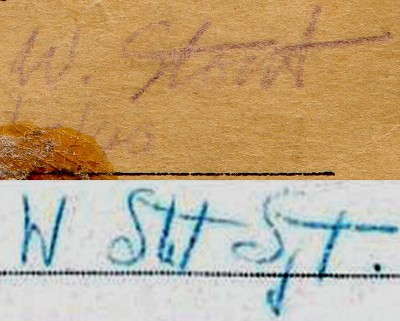If you have been following the coverage here of the recent WW2 cipher pigeon story with more than the bleariest of eyes, you’ll know that I’ve repeatedly speculated whether its “W Stot Sjt” signature might well have actually been written by Serjeant William Stout of the Royal Engineers. Though (as we’ve already seen) he died not long after D-Day, I wondered whether it might be possible to find out more about his story by tracking down surviving members of his family and asking them.
Just before Christmas, I finally managed to get in contact with Stout’s daughter, and asked if she could see if she had a copy of his signature or his handwriting. Delightfully, I received from her this last week a small package containing some wartime photographs of her father, a photograph of his grave taken in 1948, and – most surprisingly of all – a 1940 field service post card (“Army Form A. 2042 / R.A.F. Form No. 1929”). Such postcards contained a list of barely informative sentences (“I am quite well”, etc), out of which the sender crossed all those lines that did not apply: there’s an example online here.
Aha, I thought: will the signature pencilled on it turn out to match the signature on the pigeon cipher form? After some lightweight image processing, I placed the two side by side so as to compare them as reliably as I could…
You’ve worked out the answer already, I think: which is that the two names were clearly not written by the same person. Which is a shame: but despite not being a proof, it’s still very far from a disproof. In the busy fog of war, a message could easily have been written by one person (the sender), enciphered and/or copied by a second (the signaller), and then sent by pigeon by a third (the pigeon handler).
In fact, various historians have already commented to me that they thought it quite unlikely that a Serjeant in the R.E. would have had the responsibility (or even the practical means) for enciphering a message in the field. So the fact that our enciphered pigeon message was not written by Serjeant Stout might arguably make more sense than if it had been… but it’s hard to be sure either way.
All the same, it has to be said that the best cipher mysteries tend to yield their secrets slowly (at best): so perhaps we shall have to resign ourselves to waiting a little longer yet for a pigeony breakthrough… we shall see!

Also, about the Stout signature. I wouldn’t be so sure. The very long cross-bars on the ‘t’ are unusual. The ‘W’ has its left side narrower than the right in both cases. The second capital ‘S’ on the pigeon-slip is not unlike.
Emotion, pain and being in an official ‘printing’ sort of mood rather than the casual ‘flowing hand’ sort of mood could make these differences.
As it happens, I use three distinct signatures myself depending on whether or not the signature will be floating about, or only appear on official or bank papers
D.
Remember that Sjt for Sergeant is American, Canadian? not British which is Sgt. I believe this is important and you are looking in the wrong place for the signature. Somebody could easily have been seconded.
Looking at the picture you have posted I am unable to read that as Stout, there is only one letter between the two T’s
Nick, I’m pretty sure you don’t get discouraged easily! A lot depends on the medium on which a signature must be entered:
Post card. air-mail “onion-skin” paper and envelopes. teeny-tiny-tag which must be rolled up and inserted into a tiny canister. credit card receipt (already outdated). Now, do I need to layout the manifold surfaces upon which one might have to place that scrap of paper while signing it?
I worked with four gentlemen who relied on me to read their nearly unintelligible handwriting and correct their spelling and punctuation (and sometimes the multi-million-dollar spread sheets which they wrote by hand — a misplaced comma or a missing zero could mean the difference of thousands/millions of dollars.
So, if you can, see if Ms Stout has any other documents with her father’s signatures. Most telling to me (and a nod to Diane) were the cross-bars on the “t’s” , and how they fit under the top curve of the “S”.
keep on keeping on!
😉
Furthermore, is there a possibility that the “Stout” name may have had origins in “Stutt” — as in Stuttgart?
bd
Donald: feel free to look for any WW2 Serjeant with a better matching name – I’ve already looked long and hard without success, but different eyes might see something new. 🙂
Furthermore (I keep on keeping on):
My Webster’s “New Collegiate Dictionary” lengthily discusses the variations of spelling “Sergeant” (US) and “Serjeant” for British.
So, what I see is a major clue to at least the writer’s origins:
You’ve got a lot of territory to choose from, and debate. One other spelling which is totally unrelated (but I just gotta plug it in somewhere) is the name of a very well-known portrait artist: Sargent
Nick, you don’t mind my occasional “tweaks”, do you?
Respectfully yours,
bdid wonder – er 🙂
Does this mean that the Sergeant William Slat from Allegheny, Pennsylvania should be reconsidered?
Also, there is a high resolution image of the message at http://2.bp.blogspot.com/-hDyc7_8i_RA/UQ3W8DhAuxI/AAAAAAAAAHY/abuVl_p73tQ/s1600/hi_res_code_davidmartin.jpg. Note how the fold hides some of the T and the unknown letter(s).
Well Nick, I guess I was wrong and this should put it to bed.
http://www.ww2f.com/wwii-general/9914-enigma-spelling-serjeant-can-laid-rest.html
Serjeant until 1953 in british Army and only used otherwise by New Zealand.
JGHBY NUSHO MANSI RYZCT
JGHBY NUSHO MANSU RYZCT
A poem by Mansur?